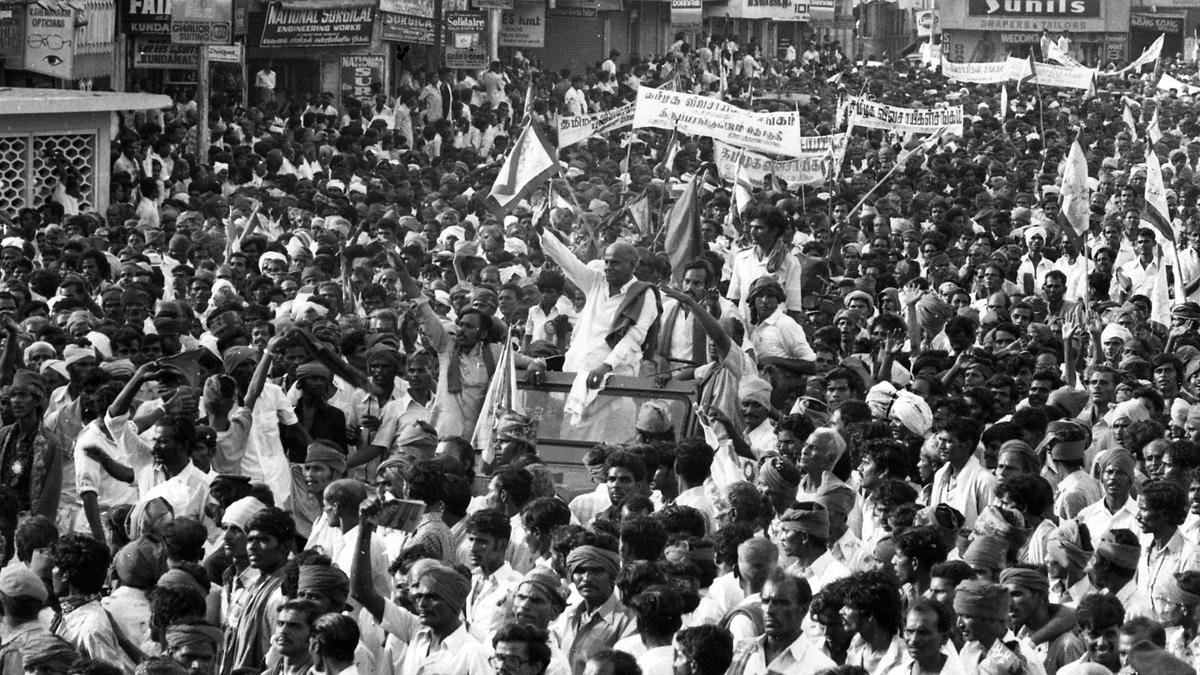
A leader who strove for farmers’ welfare, spearheading protests across Tamil Nadu Premium
The Hindu
Farmers in Tamil Nadu rallied behind C. Narayanaswamy Naidu in the 1970s for various demands, leading intense protests.
Farmers’ protests are not uncommon in India. In Tamil Nadu, too, farmers have rallied behind different leaders, like P. Ayyakannu in 2017. But such leaders have not been able to retain their support for long. But it was different five decades ago. From the late 1960s to the early 1980s, thousands of farmers from across Tamil Nadu, and even from neighbouring States, gathered to voice their demands at the call of C. Narayanaswamy Naidu. Fondly called ‘Uzhavar Perunthalaivar’ (the great leader of farmers) by his followers, Naidu spearheaded various protests during this period.
“The katta vandi porattam [the bullock cart protest] in the early 1970s was the highlight. Thousands of farmers used to block roads using the carts and picket government offices or public places until their demands were met. I was a kid then. My father used to take me along on the cart, and I used to witness these protests from close quarters,” recalls Babu, president, Narayanaswamy Naidu Vivasayigal Sangam (NNVS).
The protests were usually over a slew of issues, but centred around a major demand, which in the early 1970s was power tariff increase, says Mr. Babu. A report in The Hindu, dated April 20, 1972, highlights how the Coimbatore District Agriculturalists’ Association, the first body that Naidu formed in 1967, resolved to carry out a no-tax campaign if the government did not accede to farmers’ demands. As talks failed, the agitation continued. Many farmers were taken into custody. Subsequently, Mr. Naidu decided to go on an indefinite fast, said a report in The Hindu on July 8, 1972. Following assurances and more talks, the government, led by DMK leader M. Karunanidhi, revised the power rates.
In the subsequent years, especially from 1978, when M.G. Ramachandran was the Chief Minister, numerous protests were organised to press for a charter of nine demands, including loan waiver. The agitations became more intense after leaders, including Naidu, were arrested. In one such demonstration, the State government had even requested the Army to tackle the huge crowd of protesters. “...Agitators, numbering 3,000, attacked the police with stones when the latter tried to remove the roadblocks. After due warning and bursting of tear-gas shells, the police opened fire in the air... and getting no response, they fired at the mob, as a result of which five persons were killed...,” The Hindu reported on April 10, 1978. Protests continued well into the early 1980s, and Naidu, who was even detained under the National Security Ordinance on December 22, 1980, was at the forefront. “The government had formed a high-level committee, headed by Narayanaswamy himself, to address the demands. Through the committee and at the request of Narayanaswamy, MGR allocated funds to restore waterbodies for irrigation, granted subsidies, and facilitated spraying of fertilizer free of cost,” AIADMK veteran and former Minister C. Ponnaiyan told The Hindu.
All of Naidu’s protests were rooted in Coimbatore, says Ponnusamy, a farmer from the district, who took part at the protests in the early 1970s. However, as more farmers began to rally behind Naidu, there was a need to represent farmers across the State; hence, the Coimbatore District Agriculturalists’ Association was renamed as the Tamizhaga Vivasayigal Sangam in 1973. It went on to represent farmers nationwide, under Naidu’s leadership, he added.
His son C.N. Nandagopal led the Tamizhaga Vivasayigal Sangam for a while, after Naidu’s death in 1984, before passing away in 1990. In 2019, it was renamed as the NNVS, which Mr. Babu has been heading for the last few years.
“There was no leader for farmers at that time. Since Ayya [Naidu] had highlighted the most important problems of all and raised issues that mattered the most, the farmers rallied behind him. I was 22, when protests were going on in Vellore over power tariff. Despite my commitment to my family, I took part in the protest, awestruck by Ayya’s dedication, and even went to prison,” recalls Mr. Ponnusamy, who is in his seventies now.

Lumara, a new resto-bar in Bengaluru, takes inspiration from the Mediterranean style of architecture
Located in the heart of the city, Lumara has innovative cocktails, and a global menu












